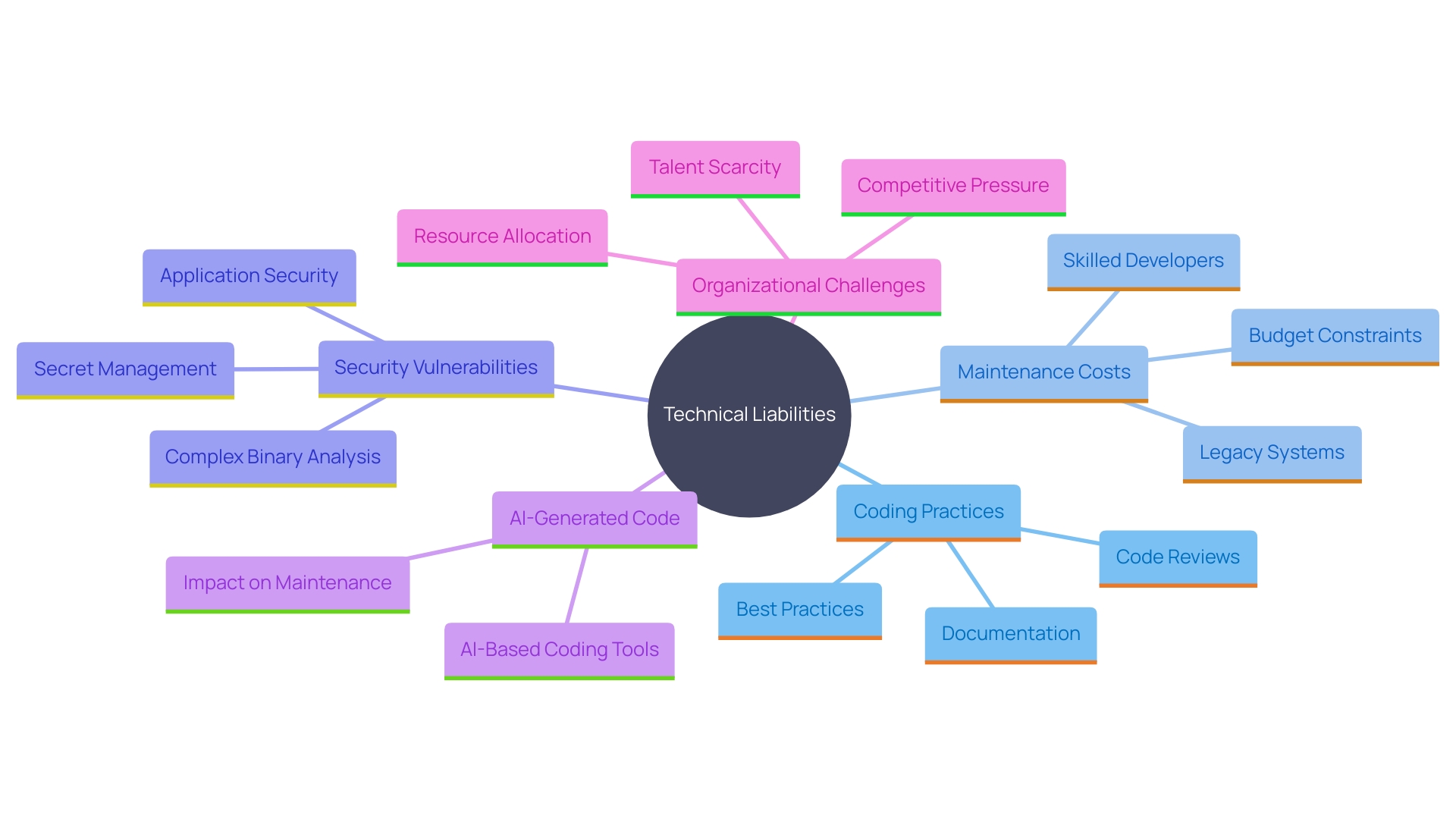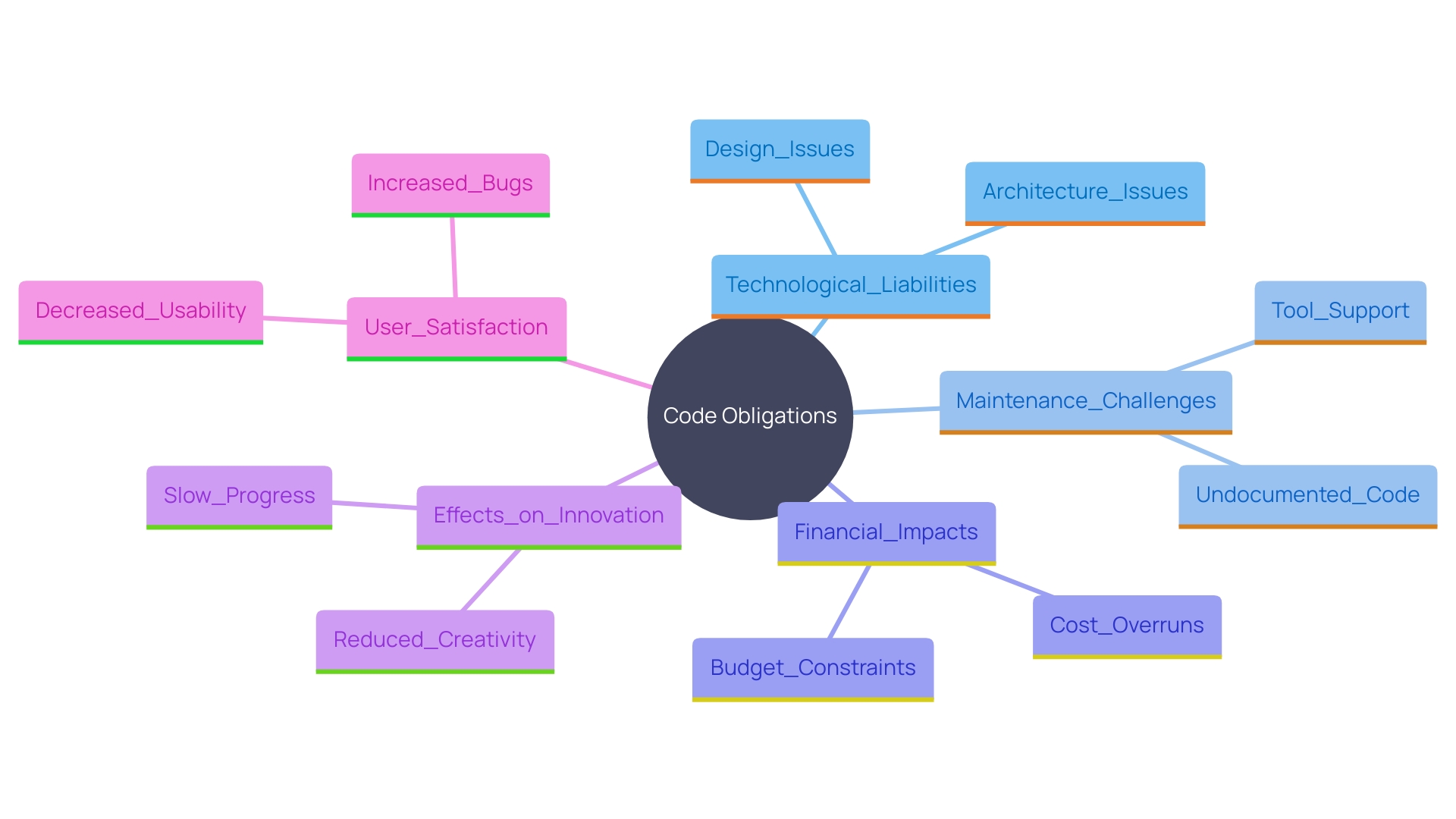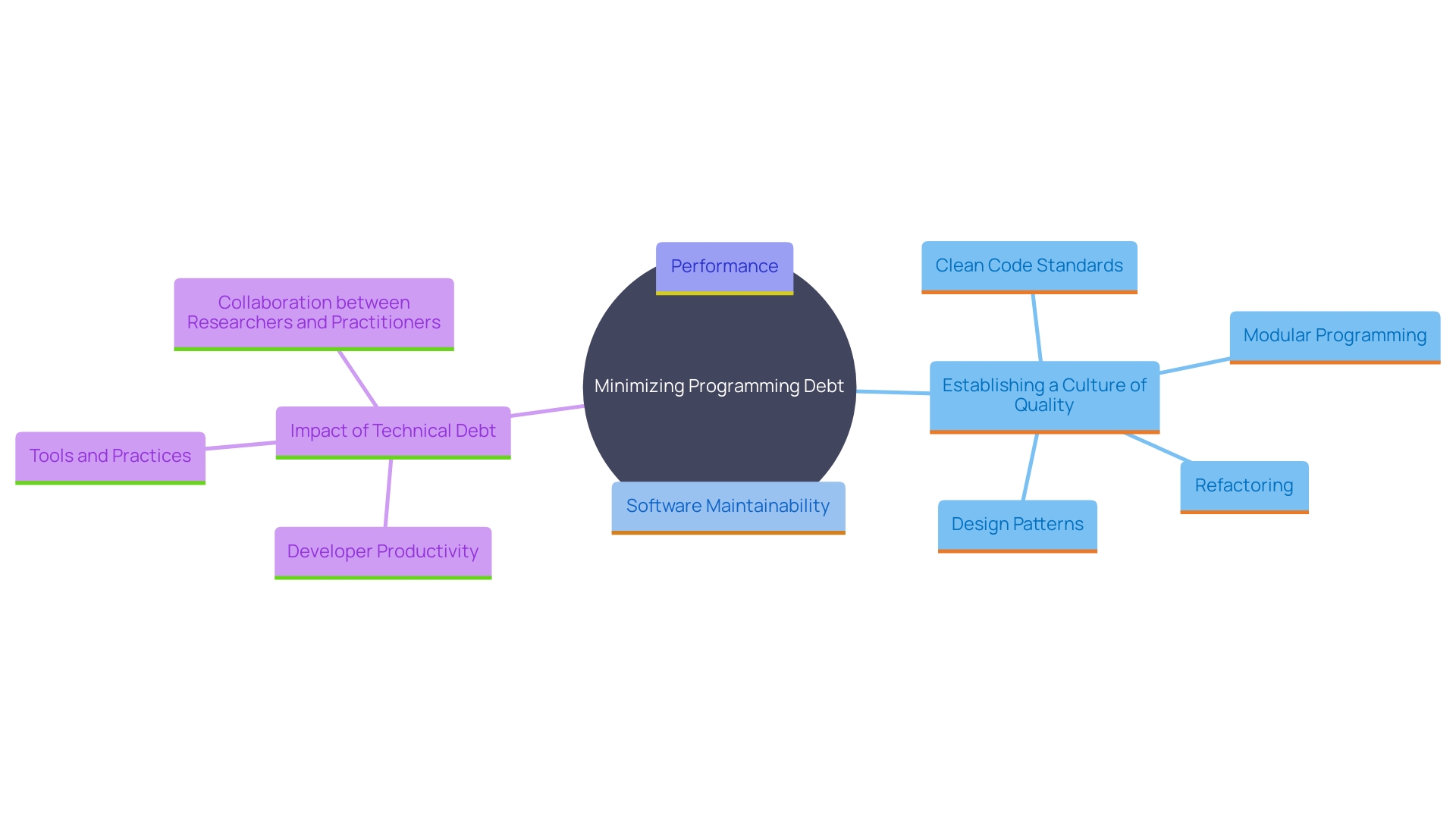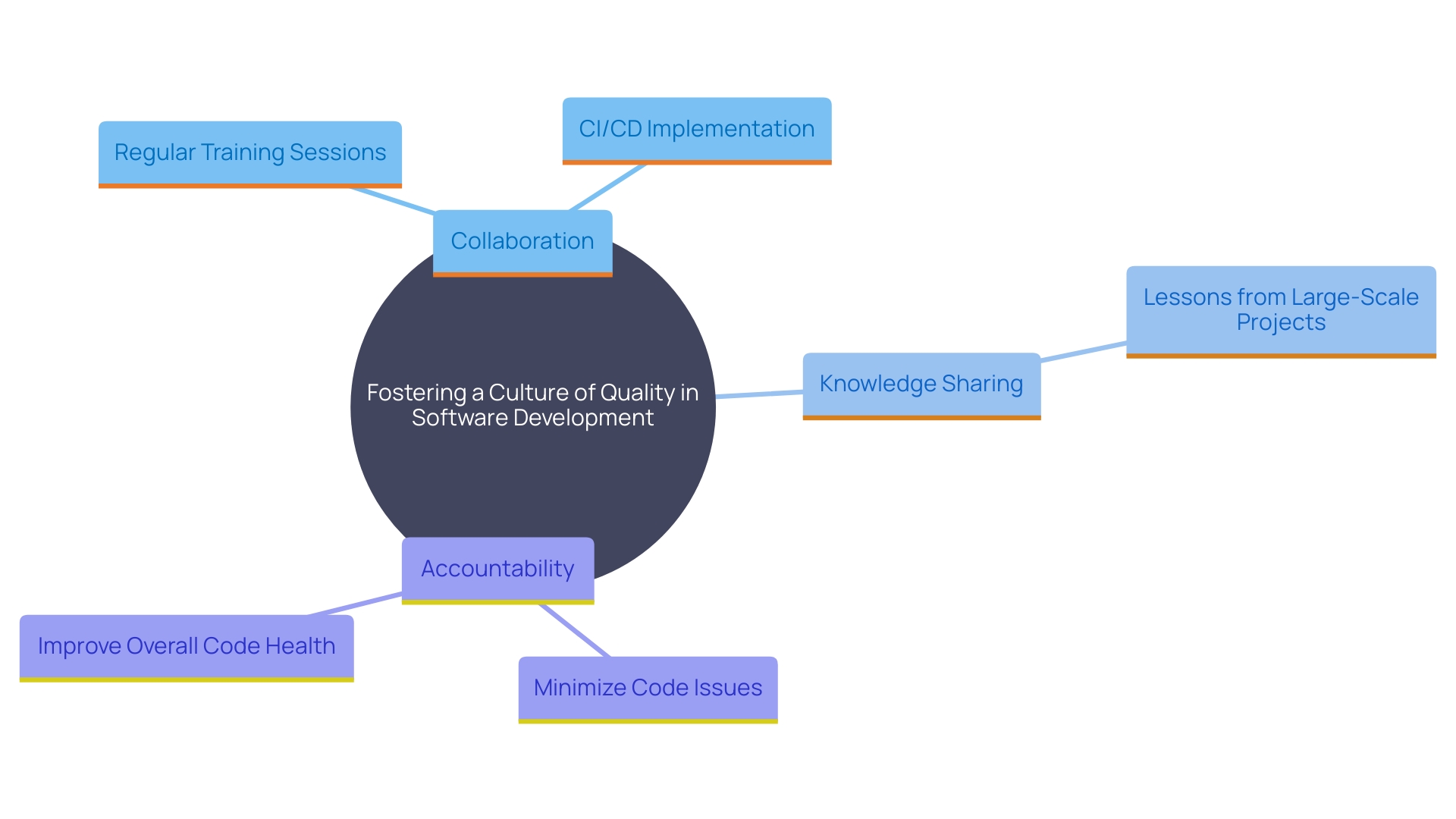Introduction
In the fast-paced world of software development, balancing the need for rapid innovation with long-term sustainability is a formidable challenge. Central to this dilemma is the concept of technical debt, also known as code debt, which refers to the accumulation of suboptimal coding practices adopted to meet deadlines or achieve quick results. This article delves into the multifaceted nature of technical debt, exploring its various categories, the profound impacts it has on organizations, and effective strategies for managing and reducing it.
By understanding and addressing technical debt, businesses can enhance software performance, scalability, and security, ultimately driving higher productivity and better outcomes.
What is Code Debt?
Technical liabilities, also known as code liabilities, refer to the accumulation of suboptimal coding practices that developers adopt to meet deadlines or achieve quick results. This often leads to increased maintenance costs and reduced system performance over time. More than 90% of organizations indicate being weighed down by technological obligations, resulting in increased development expenses and postponements or cancellations of essential projects. Maintaining legacy systems significantly contributes to this burden, making it expensive and challenging to add new capabilities or manage core functions like performance, scalability, and resilience.
In the context of software security, technical liabilities also manifests as unremediated flaws that persist for over a year. Research has shown that 42% of applications contain such security vulnerabilities. The rise of AI-generated code has exacerbated this issue, introducing insecure code at scale. Efficient oversight of software liabilities entails recognizing and resolving these challenges, frequently necessitating experienced developers to guarantee that new and current applications stay efficient, scalable, secure, and compliant.
The challenge to handle technological obligations is made more difficult by restricted finances, a shortage of IT professionals, and the intricacy of managing various programming languages. Organizations must balance the competitive pressure to provide contemporary solutions with the realities of their current system liabilities. Sophisticated instruments and joint initiatives among researchers and practitioners are crucial to alleviate the long-term effects of technical liabilities on application development.

Categories of Technical Debt
Technical obligations manifest in several forms, each with distinct implications for software development. Design liabilities arise from suboptimal design choices that hinder future scalability, resulting in higher expenses when modifications are needed. Architectural obligations involve core system elements that obstruct integration with emerging technologies. Documentation obligations, on the other hand, arises from insufficient commenting and lack of user manuals, complicating the maintenance and comprehension of code for future developers.
The idea of software liabilities has changed considerably since its official explanation by a group of scholars, industry specialists, and tool providers in 2016. This alignment between academia and industry has highlighted the need for a comprehensive toolbox to manage technological obligations, recognizing that there is no one-size-fits-all solution. The interest in tackling software liabilities increased after a 2010 Future of Software Engineering workshop, which envisioned improved productivity and quality in software development through better understanding and management of these issues.
Industry reports, such as those by InfoQ, have documented the shift from broader themes to more specific tools and technologies. This change highlights the significance of focused solutions in managing technology liabilities efficiently. For instance, design liabilities were previously a general concern, but now specific design patterns and tools are being developed to address it directly.
The concept of 'interest' in system obligations is essential, indicating the extra expenses incurred when alterations are made to a system weighed down by obligations. This interest can influence current application development by slowing down velocity or appearing later due to unexpected liabilities, such as the discontinuation of third-party libraries. By understanding and classifying software liabilities, developers and managers can make informed choices that balance immediate functionality with long-term sustainability.
Impacts of Code Debt
The effects of code obligations can be significant, influencing both the performance and maintainability of applications. Over ninety percent of organizations are weighed down by technological liabilities, resulting in higher expenses for software creation and oversight. 'This obligation often leads to postponed or canceled essential business projects, as well as increased expenses to maintain vital processes operating on outdated systems.'.
Elevated amounts of maintenance challenges hinder the addition of new capabilities and the management of essential functions such as performance, scalability, and resilience. Businesses are under immense pressure to innovate and bring modern solutions to market, but they struggle to keep pace due to limited budgets and a scarcity of IT talent.
The accumulated financial obligation compels teams to invest additional time on upkeep, diverting resources away from creating new features. This maintenance burden ultimately affects product quality and user satisfaction. As one survey revealed, the cost and effort of managing legacy systems are enormous, contributing significantly to the technical burden that hampers innovation.

Strategies for Managing Code Debt
Effectively managing technical debt requires a strategic and proactive approach. Routine evaluations of programming and refactoring meetings are crucial to recognize and tackle problematic areas before they develop into bigger concerns. For instance, at DebtBook, a company offering financial solutions to government and educational institutions, implementing rigorous code review processes was crucial in maintaining high standards despite the complexity of their environment.
Utilizing automated testing and continuous integration (CI) is another fundamental practice. CI not only simplifies the development process but also fosters a culture of teamwork, efficiency, and a dedication to providing high-quality products. By catching issues early, teams can reduce the risk of post-release problems, as seen in M&T Bank's approach to maintaining their software's integrity and compliance in the highly regulated banking industry.
Setting and following coding guidelines fosters uniformity and reduces the likelihood of incurring technical liabilities. The fast-paced evolution of the IT industry means that components such as tools, frameworks, and libraries can quickly become obsolete. This can lead to integration and maintenance challenges, particularly for inexperienced development teams.
Prioritizing technical debt remediation in project planning ensures systematic addressing of these issues. Case studies emphasize that a lack of comprehension of best practices and inefficient project management can considerably diminish quality of the software over time. However, by integrating regular programming evaluations and leveraging automated tools, organizations can enhance their software's reliability and maintainability, ultimately driving higher productivity and better outcomes.
Best Practices for Code Debt Reduction
Minimizing programming debt is essential for sustaining a healthy, efficient software repository. Implementing a culture of quality, where every team member prioritizes clean, maintainable code, is fundamental. An example worth noting is M&T Bank, which established organization-wide Clean Code standards to support software maintainability and performance. Promoting the use of design patterns and modular programming can also reduce the buildup of obligations. This method aligns with the Code Health metric, which aggregates around 25 design properties to categorize software as Green, Yellow, or Red, providing a clear view of quality.
Furthermore, setting aside specific time during sprints to tackle technical liabilities is essential. In agile and scrum methodologies, this involves adding tasks for minimizing development liabilities to the backlog, ensuring they are prioritized. This practice maintains developer velocity and productivity by preventing the accumulation of low-quality software. The significance of handling technical debt is highlighted by the fact that unhealthy programming can take up to ten times longer to work with compared to healthy programming, putting businesses at a significant disadvantage.
Refactoring plays a significant role in this process. It's the practice of enhancing software by modifying its internal structure without altering its external behavior, making it easier to comprehend, maintain, and adjust. By understanding when and how to refactor, developers can ensure their work remains optimized and productive. This continuous improvement process enhances the readability, maintainability, and overall quality of the codebase, benefiting both current and future developers.

Fostering a Culture of Quality
Promoting a culture of quality within a development team is essential for minimizing code issues. This involves encouraging collaboration, knowledge sharing, and accountability among team members. Regular training sessions on best coding practices and ongoing discussions about technical debt can empower developers to take ownership of their work. Drawing lessons from large-scale engineering projects like the Hoover Dam, which was completed ahead of schedule despite significant challenges, can provide valuable insights into managing complex software development projects. Implementing continuous integration and continuous delivery (CI/CD) pipelines, robust testing, and automation processes are essential strategies. According to a study on Code Health metrics, a healthy codebase can significantly reduce the time required to implement new capabilities, offering a competitive advantage in the marketplace. Essentially, prioritizing quality over speed can lead to more sustainable and efficient development outcomes.

Conclusion
The multifaceted nature of technical debt presents significant challenges for organizations striving for both rapid innovation and long-term sustainability. Understanding the various forms of code debt—such as design, architectural, and documentation debt—enables teams to make informed decisions that balance immediate needs with future growth. The pervasive impact of technical debt on software performance and maintainability underscores the urgency for effective management strategies.
Implementing proactive measures, such as regular code reviews, automated testing, and adherence to coding standards, fosters a culture of quality that is essential for reducing code debt. By prioritizing the remediation of technical debt within project planning and dedicating resources to address it, organizations can enhance their software's reliability and maintainability. This not only drives higher productivity but also leads to better overall outcomes.
Ultimately, fostering an environment where quality is paramount and continuous improvement is embraced can significantly mitigate the long-term impacts of technical debt. By investing in the health of the codebase, businesses position themselves for sustained success in a competitive landscape, ensuring they remain agile and responsive to evolving market demands.
Frequently Asked Questions
What are technical liabilities?
Technical liabilities, also known as code liabilities, refer to suboptimal coding practices adopted by developers to meet deadlines or achieve quick results. These practices can lead to increased maintenance costs and reduced system performance over time.
How prevalent are technical liabilities in organizations?
More than 90% of organizations report being burdened by technological obligations, which can result in increased development expenses and the postponement or cancellation of essential projects.
What are the main types of technical liabilities?
Technical liabilities manifest in several forms: Design liabilities (poor design choices affecting future scalability), Architectural obligations (core system elements hindering integration with new technologies), and Documentation obligations (insufficient comments and lack of user manuals complicating code maintenance).
What impact do technical liabilities have on software security?
Technical liabilities can result in unremediated security flaws that persist for over a year. Research indicates that 42% of applications contain security vulnerabilities, exacerbated by the rise of AI-generated code introducing insecure code at scale.
What challenges do organizations face in managing technical liabilities?
Organizations struggle with limited budgets, shortages of IT professionals, the complexity of managing various programming languages, and balancing the pressure to deliver modern solutions with existing system liabilities.
How can organizations effectively manage technical debt?
Effective management of technical debt involves routine evaluations of programming, conducting refactoring meetings, implementing automated testing and continuous integration (CI), setting and following coding guidelines, and prioritizing technical debt remediation in project planning.
What is the role of refactoring in managing technical liabilities?
Refactoring enhances software by modifying its internal structure without changing its external behavior. This practice improves code readability, maintainability, and overall quality, benefiting both current and future developers.
How can a culture of quality minimize technical liabilities?
Promoting a culture of quality involves encouraging collaboration, knowledge sharing, and accountability among team members, regular training sessions on best coding practices, and implementing CI/CD pipelines and robust testing to improve code health.
What is the significance of understanding 'interest' in system obligations?
The concept of interest refers to the extra expenses incurred when making changes to a system burdened by liabilities. Understanding this can help developers and managers make informed decisions that balance immediate functionality with long-term sustainability.
How does technical debt affect innovation?
The accumulated financial burden of technical debt can divert resources from developing new features, leading to postponed or canceled essential projects and hindering overall innovation.
What strategies can organizations implement to improve software quality?
Organizations can improve software quality by establishing clean code standards, promoting design patterns and modular programming, and setting aside time during development sprints to address technical liabilities.
Why is it crucial to address technical liabilities proactively?
Proactively addressing technical liabilities helps prevent them from escalating into bigger issues, ensuring that applications remain efficient, scalable, secure, and compliant over time.




